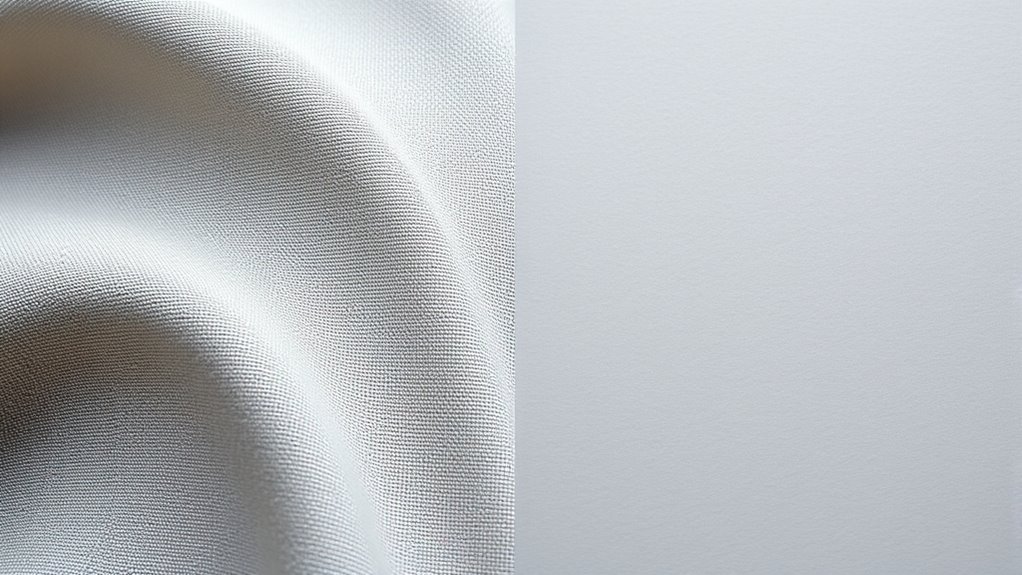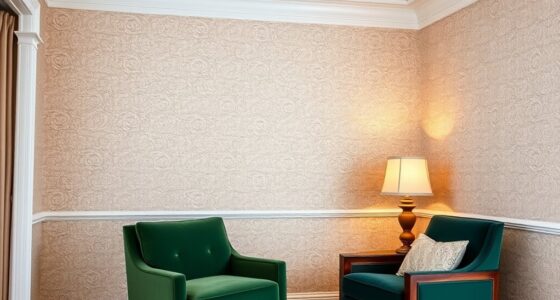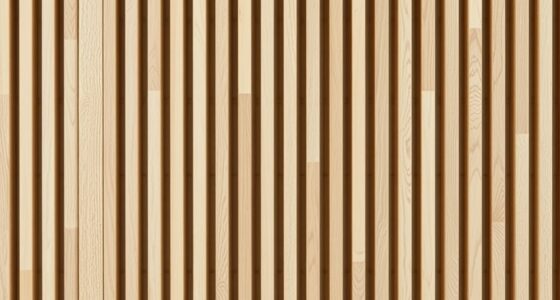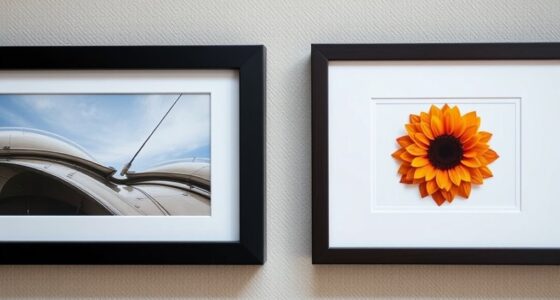When choosing between liner fabrics and lining paper for murals, consider your wall surface and desired texture. Liner fabrics are flexible, ideal for uneven or textured walls, and can add subtle depth and tactile qualities. Lining paper offers a smooth, uniform surface that enhances fine detail and color clarity on smooth walls. Both materials work with different adhesives, but your choice depends on wall condition and artistic goals—discover more about which option suits your project best.
Key Takeaways
- Liner fabrics are flexible, textured textiles suitable for uneven surfaces, while lining paper provides a smooth, flat base for detailed murals.
- Liner fabrics enhance wall durability and add tactile depth; lining paper emphasizes fine detail with a sleek finish.
- Liner fabrics bond well with various adhesives and can accommodate irregular wall textures; lining paper requires smooth, well-prepared surfaces.
- Liner fabrics are made from cotton, polyester, or blends, offering texture variation; lining paper is lightweight, uniform, and designed for smooth application.
- Choose liner fabrics for textured, durable murals; select lining paper for precise, detailed artwork on smooth walls.

When choosing between liner fabrics and lining paper, understanding their distinct qualities is essential for your project. Both options serve to prepare walls for murals, but they differ markedly in terms of adhesive compatibility and texture variation. Recognizing these differences helps you select the best material to ensure a smooth application and long-lasting finish.
Choosing the right wall preparation: fabrics offer texture and flexibility, while lining paper provides a smooth, detailed surface.
Liner fabrics are versatile textiles that can be made from materials like cotton, polyester, or blended fibers. They provide a flexible, durable base that adapts well to uneven surfaces, making them ideal for textured walls. One of the key advantages of liner fabrics is their high adhesive compatibility. They readily bond with various adhesives, allowing you to work with different types of mural glue without concern for the fabric’s compatibility. This flexibility ensures that your mural adheres securely, even over challenging surfaces. Additionally, the texture variation inherent in fabrics can add a subtle depth to your mural. Depending on the weave and thickness you choose, the fabric can introduce a slight tactile quality, which may enhance the visual interest of your finished piece.
Lining paper, on the other hand, is a thinner, more uniform material typically made from high-quality paper designed specifically for wall preparation. It’s lightweight and easy to handle, making it a popular choice for quick applications. When it comes to adhesive compatibility, lining paper generally works well with standard wallpaper adhesives, but you need to be mindful of the type of glue you use. Some adhesives may not bond as effectively to lining paper, particularly if the surface is very smooth or coated, so testing a small area beforehand is recommended. Regarding texture variation, lining paper offers a smooth, flat surface that’s ideal for detailed murals and artwork. Its uniformity ensures that the mural’s colors and fine details are displayed clearly without interference from surface irregularities. However, this smoothness might make it less forgiving on uneven walls, requiring proper wall preparation to prevent issues like bubbling or cracking.
Ultimately, your choice hinges on the specific needs of your mural project. If you want a flexible, textured base with excellent adhesive compatibility, liner fabric might be the better option. If you prefer a smooth, straightforward surface that emphasizes fine detail, lining paper could be your best bet. Both materials have their strengths, but understanding how they interact with adhesives and how their textures can influence your final outcome ensures you make an informed decision, leading to a professional, lasting mural.
Frequently Asked Questions
Which Option Is More Environmentally Friendly for Murals?
You should choose lining paper for murals if you’re aiming for a more environmentally friendly option. It generally has a lower eco impact because it’s often made from recyclable materials and is biodegradable, reducing waste. Lining paper’s recyclability makes it a smarter choice for eco-conscious projects, helping you minimize your environmental footprint. Plus, it’s easier to dispose of responsibly, making it a more sustainable option overall.
How Do Installation Times Compare Between Fabrics and Paper?
When it comes to installation speed, fabrics usually go up faster than lining paper, making setup simpler overall. You won’t want to be caught between a rock and a hard place, especially if time is tight. Fabrics often require less prep work and fewer seams, so you can finish your mural quicker. If speed matters, fabrics are your best bet for a smooth, hassle-free installation process.
Can Both Options Be Used Outdoors Effectively?
You can use both liner fabrics and lining paper outdoors, but fabrics generally offer better weather resistance. Fabrics are designed to withstand moisture, UV rays, and temperature changes, maintaining good surface adhesion longer. Lining paper, on the other hand, tends to degrade faster outdoors due to less weather resistance, which can compromise surface adhesion. For outdoor murals, fabrics are usually the more durable, long-lasting choice.
What Are the Costs Differences Over the Mural’s Lifespan?
Think of durability as the backbone of your mural’s longevity. You’ll find that liner fabrics typically have a higher initial cost but offer superior durability, reducing repair expenses over time. Meanwhile, lining paper costs less upfront but may require frequent replacements, increasing long-term expenses. Conducting a thorough cost analysis, considering durability comparison, helps you decide which option saves you money in the long run, ensuring your mural stays vibrant and intact.
Are There Specific Murals Better Suited for Each Material?
You’ll find that fabric liners suit murals needing enhanced fabric durability and a textured appearance, making them ideal for artistic, textured murals. Conversely, lining paper works better for smooth, flat murals where you want a sleek finish. Consider the mural’s desired texture and longevity; fabric adds durability and a unique feel, while lining paper offers a cost-effective, smooth surface. Match the material to your mural’s specific visual and physical needs for best results.
Conclusion
Ultimately, choosing between liner fabrics and lining paper depends on your mural’s needs. Some believe that fabric’s durability makes it the better choice, but recent tests suggest lining paper can be surprisingly resilient if applied correctly. So, don’t just rely on tradition—consider trying both to see what works best for your project. After all, experimenting might just reveal the secret to a flawless mural that lasts.









